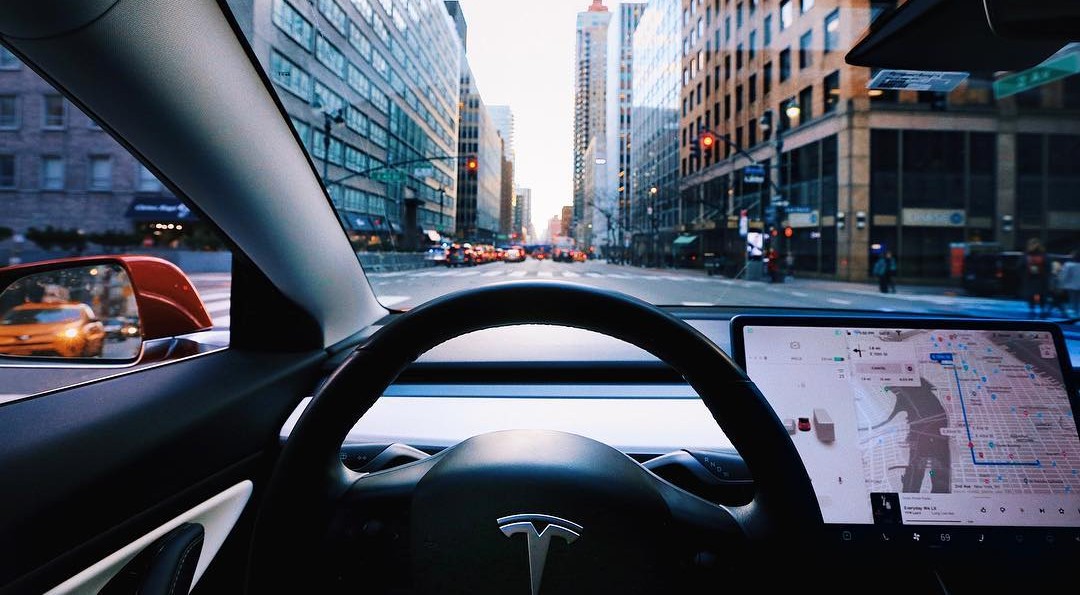
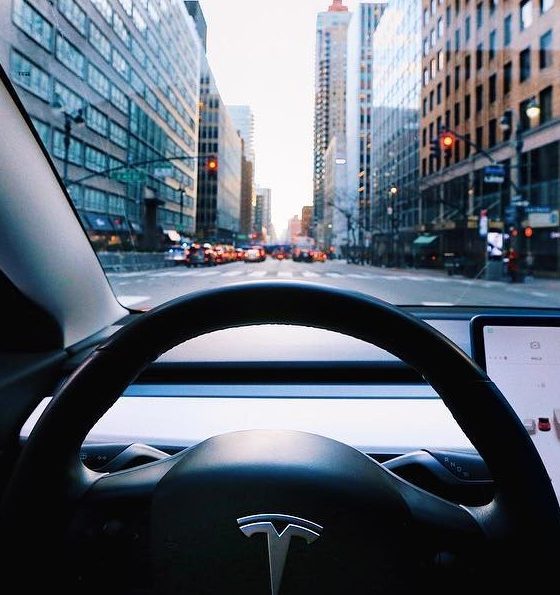
News
Tesla’s software fixes, the NHTSA’s status quo, and an impending need for updated recall terminologies
It is no secret that Tesla is a popular topic, so much so that the coverage around the company is immense. Couple this with CEO Elon Musk’s rockstar persona and you get a company whose vehicles are looked at under a microscope constantly. It might feel unfair for some, but it’s just the way it is. Tesla — by simply being Tesla — is newsworthy.
Tesla’s newsworthiness is a double-edged sword. A look at the coverage for the company’s vehicle recalls from the NHTSA would prove this point. So notable is Tesla’s news coverage that a mainstream newsreader would likely get the impression that Teslas get recalls frequently. The opposite is true. As evidenced by Reuters in the graphic below, data from January 1, 2020, through February 17, 2022, shows that Tesla actually recalls its vehicles less frequently than some of the market’s leading automakers. Tesla is also the only carmaker performing a large share of its vehicle recalls through over-the-air software updates.
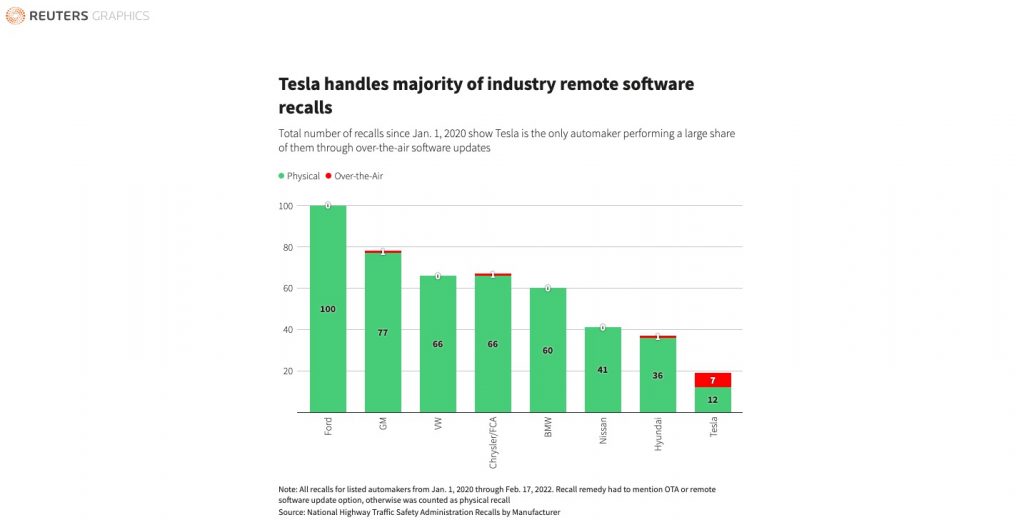
Tesla currently handles the majority of the industry’s remote software recalls, but it would soon not be the only one. New electric vehicle makers have used the idea of software updates as a means to promote their EVs’ capabilities. Rivian has performed OTA updates to its R1 vehicles, and those cars are only starting customer deliveries. Lucid is the same with its Air sedan, with the company rolling out features like Automatic Emergency Braking, Cross-Traffic Protection, Lane Departure Protection, Traffic Drive-Off Alert, and other features earlier this month through a software update. Ford has been rolling out updates called “Power-Ups” to the Mustang Mach-E as well.
Considering that software-based fixes are only bound to get more widespread over the coming years, one must then ask the question: Should software-based over-the-air fixes be dubbed and classified with the same terminologies as physical recalls, which typically involve the replacement of vehicle hardware?
A Vastly Different “Recall” Experience
Any car owner has likely experienced a recall for their vehicle at some point in their driving life. And more likely than not, one’s experience is probably not that pleasant. I certainly count myself among drivers who look at vehicle recalls with trepidation. My current vehicle, a Japanese-made van, was part of a minor fuel pump recall a couple of years ago, and even addressing that took a whole day out of my weekend. The dealer was overwhelmed with the number of cars it was fixing that day, and tempers among owners were flaring by the hour — all for a simple fuel pump replacement. I’ve been told that my experiences with vehicle recalls are not that unique.
In comparison, a software-based fix, such as the disabling of FSD Beta’s “rolling stops” feature, only required affected vehicles to be connected to the internet. There was no dealer visit, no forms to fill out, and no staff to argue with. The car was connected to the internet, a software fix was implemented, and the issue was resolved. One can argue that Tesla’s software fix to disable FSD Beta’s “rolling stops” feature was safety-related, and that’s true. But one could also argue that at least from a driver’s point of view, the experience related to software and hardware-based recalls is vastly different.
The Status Quo
Despite the different experiences involved when software and hardware-based vehicle recalls are addressed, it appears that the National Highway Traffic Safety Administration (NHTSA) will, at least for now, keep the status quo. Teslarati reached out to the NHTSA to inquire if it was considering the adoption of updated terminologies for cars whose fixes are completed through OTA software updates, but the agency suggested that this would likely not be the case, at least for now. According to the NHTSA, vehicle manufacturers must initiate a recall for any repair that remedies a safety risk, regardless of whether the issue is fixed by software update or by hardware replacement.
“The National Highway Traffic Safety Administration is committed to ensuring the highest safety standards on the nation’s roadways. NHTSA is empowered with robust tools and authorities to protect the public, to investigate potential safety issues, and to compel recalls when it finds evidence of noncompliance or an unreasonable risk to safety. Manufacturers are required to initiate a recall for any repair, including a software update, that remedies an unreasonable risk to safety. NHTSA recalls can include any required repair, which includes a software update, to remedy a potential safety risk. Manufacturers are also required to submit any communications to owners, dealers, and others about any software updates that address a defect, whether it is safety-related or not,” the NHTSA stated.
Product recall specialist and associate professor at the Indiana University Kelley School of Business Professor George Ball told Teslarati that while the NHTSA’s use of similar terminologies for software and hardware-based recalls is “definitely an example of regulators and industry moving at a different pace on technology,” the agency’s hesitation in adopting new terminologies for OTA fixes is understandable. Professor Ball further explained that using terms such as “soft recall” to refer to software-based vehicle fixes might imply a reduced level of risk, and this is something that the NHTSA would likely be unwilling to do.
“I believe NHTSA would resist ‘soft recall’ terminology because it implies a reduced level of customer hazard and allows the firm to be under less scrutiny by the press and public for quality corrections. While some updates are minor, some of the Tesla software upgrades are actually quite serious, and if not done, can allow a harmful defect to persist,” the recall specialist said.
But while the NHTSA’s stance on recall terminologies is completely understandable, one cannot deny the fact that the issues covered by vehicle recalls have a very wide range of risks. Take Tesla’s recall for 817,143 vehicles, which was announced earlier this month, for example. The recall was initiated since a software error may prevent a warning chime from activating even if drivers do not have their seat belts on. From a layman’s perspective, this recall seems grave as it affects over 800,000 Teslas on the road today. However, the issue was simply addressed through firmware release 2021.43.101.1 and later, which included a remedy for the seat belt chime error.
Compare this with General Motors’ recall last year of 400,000 pickup trucks in the US. Granted, it only affected about half as many vehicles as Tesla’s seat belt chime recall, but its hardware-based nature suggested that the risk presented by the issue was great. The recall covered certain 2015 and 2016 Chevrolet and GMC Sierra 1500, 2500, and 3500 trucks, and it involved a faulty airbag inflator that may rupture without warning. To fix the issue, owners of the affected trucks were required to head to a dealer so that they could get their airbag modules replaced. Since parts were in short supply last year, however, owners were notified with a letter to inform them when their trucks’ replacement parts were available.
What Can Be Done
While the NHTSA will likely continue to maintain the status quo with its recall terminologies for the foreseeable future, Professor Ball told Teslarati that the agency can actually implement some adjustments now that can make distinguishing safety fixes and issues clearer. This would likely be extremely important in the near future as more connected cars are rolled out and software updates become the norm.
“If I were to provide advice to the NHTSA, I would recommend that they get out ahead of this issue before every car maker starts updating cars like Tesla. One way to do it is to require the automaker to send all auto updates to NHTSA when pushed out, and to classify updates as ‘minor’ or ‘major.’ Any major update that impacts customer safety would be classified as a recall. Automakers won’t like this, but it will help keep the safety fixes transparent for all, especially consumers. By sending all updates to NHSTA, the agency could assign qualified people to audit the classifications assigned by the manufacturer, to ensure they are making good decisions there.
“I think any language that de-emphasizes the importance of a safety recall is not likely to be supported by NHTSA, and it doesn’t likely help customer safety. A clear distinction needs to be made between minor updates and major updates that influence safety. Those major updates should be classified as a recall, and NHTSA needs to get their arms around these updates and keep on top of them soon, or they will fall way behind the industry,” the recall specialist said.
Recalls can affect the perception of a company to the public. Software fixes should be one of the factors that are considered an edge for automakers like Tesla, not the other way around. Gary Black, Managing Partner of The Future Fund LLC, explained this from the point of view of a Tesla investor. “Since every NHTSA recall so far has been quickly solvable via Tesla OTA updates, ‘recalls’ are noise to most investors. Tesla’s huge software edge highlights one of the key advantages of owning Tesla over every other EV manufacturer,” the Wall Street veteran told Teslarati.
OTA updates, including those related to vehicle safety, are coming. With automakers like Ford joining the group of carmakers embracing OTA updates, software-based fixes are inevitable. Ultimately, I am inclined to agree with the recall specialist. By refusing to adapt to the advent of software-based vehicle fixes, the NHTSA may risk being left behind by the automotive industry. And that’s a scenario that I believe no automaker — or government agency for that matter — would prefer.
Don’t hesitate to contact us with news tips. Just send a message to simon@teslarati.com to give us a heads up.

News
Tesla dominates in the UK with Model Y and Model 3 leading the way
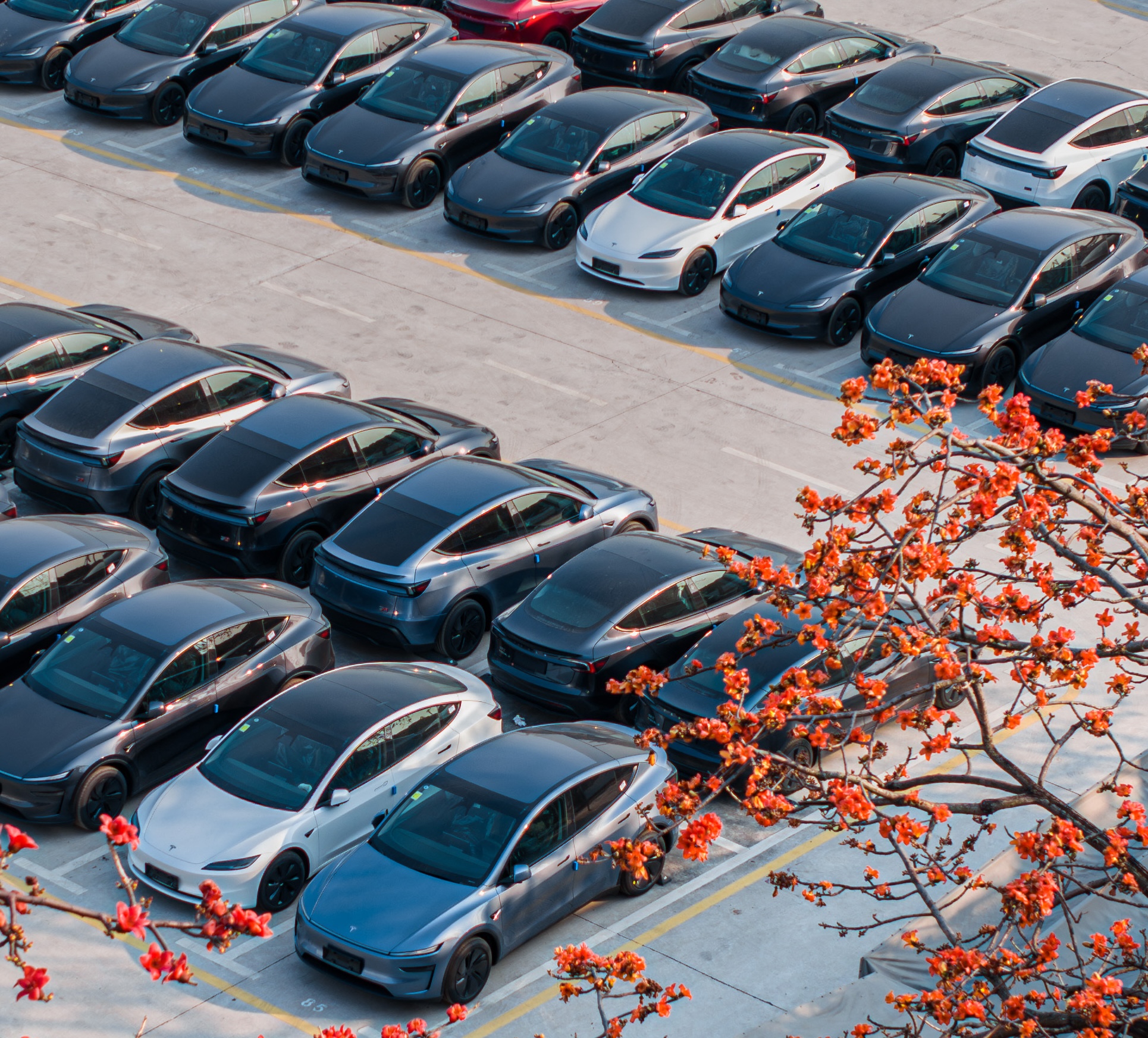
Tesla is dominating in the United Kingdom so far through 2025, and with about two weeks left in the year, the Model Y and Model 3 are leading the way.
The Model Y and Model 3 are the two best-selling electric vehicles in the United Kingdom, which is comprised of England, Scotland, Wales, and Northern Ireland, and it’s not particularly close.
According to data gathered by EU-EVs, the Model Y is sitting at 18,890 units for the year, while the Model 3 is slightly behind with 16,361 sales for the year so far.
The next best-selling EV is the Audi Q4 e-tron at 10,287 units, lagging significantly behind but ahead of other models like the BMW i4 and the Audi Q6 e-tron.
GOOD NEWS 🇬🇧 Tesla is absolutely crushing the UK electric vehicle market in 2025 💥
The numbers are in, and the dominance is clear. With an impressive amount of 42,270 vehicles delivered year-to-date, the brand now commands a solid 9.6% market share of the total auto market 🆒… pic.twitter.com/dkiGX9kzd0
— Ming (@tslaming) December 18, 2025
The Model Y has tasted significant success in the global market, but it has dominated in large markets like Europe and the United States.
For years, it’s been a car that has fit the bill of exactly what consumers need: a perfect combination of luxury, space, and sustainability.
Both vehicles are going to see decreases in sales compared to 2024; the Model Y was the best-selling car last year, but it sold 32,610 units in the UK. Meanwhile, the Model 3 had reached 17,272 units, which will keep it right on par with last year.
Tesla sold 50,090 units in the market last year, and it’s about 8,000 units shy of last year’s pace. It also had a stronger market share last year with 13.2 percent of the sales in the market. With two weeks left in 2025, Tesla has a 9.6 percent market share, leading Volkswagen with 8 percent.
The company likely felt some impact from CEO Elon Musk’s involvement with the Trump administration and, more specifically, his role with DOGE. However, it is worth mentioning that some months saw stronger consumer demand than others. For example, sales were up over 20 percent in February. A 14 percent increase followed this in June.
News
Tesla Insurance officially expands to new U.S. state
Tesla’s in-house Insurance program first launched back in late 2019, offering a new way to insure the vehicles that was potentially less expensive and could alleviate a lot of the issues people had with claims, as the company could assess and repair the damage itself.
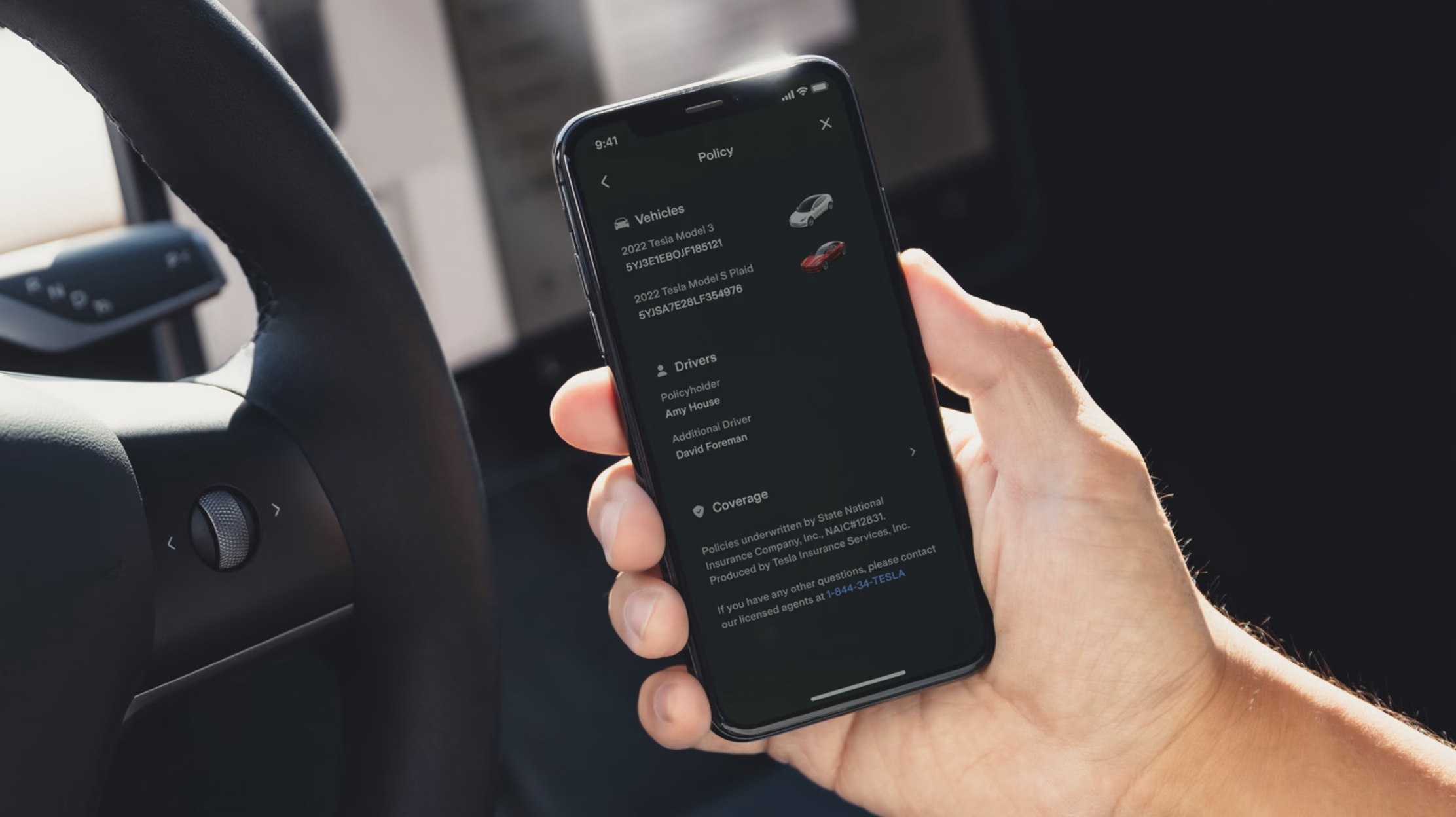
Tesla Insurance has officially expanded to a new U.S. state, its thirteenth since its launch in 2019.
Tesla has confirmed that its in-house Insurance program has officially made its way to Florida, just two months after the company filed to update its Private Passenger Auto program in the state. It had tried to offer its insurance program to drivers in the state back in 2022, but its launch did not happen.
Instead, Tesla refiled the paperwork back in mid-October, which essentially was the move toward initiating the offering this month.
BREAKING: Tesla Insurance has just officially launched in Florida.
This is the first new state to receive @Tesla Insurance in more than 3 years. In total, Tesla insurance is now available in 13 U.S. states (map in thread below of all the states).
Tesla Insurance in Florida uses… pic.twitter.com/bDwh1IV6gD
— Sawyer Merritt (@SawyerMerritt) December 17, 2025
Tesla’s in-house Insurance program first launched back in late 2019, offering a new way to insure the vehicles that was potentially less expensive and could alleviate a lot of the issues people had with claims, as the company could assess and repair the damage itself.
It has expanded to new states since 2019, but Florida presents a particularly interesting challenge for Tesla, as the company’s entry into the state is particularly noteworthy given its unique insurance landscape, characterized by high premiums due to frequent natural disasters, dense traffic, and a no-fault system.
Annual average premiums for Florida drivers hover around $4,000 per year, well above the national average. Tesla’s insurance program could disrupt this, especially for EV enthusiasts. The state’s growing EV adoption, fueled by incentives and infrastructure development, aligns perfectly with Tesla’s ecosystem.
Moreover, there are more ways to have cars repaired, and features like comprehensive coverage for battery damage and roadside assistance tailored to EVs address those common painpoints that owners have.
However, there are some challenges that still remain. Florida’s susceptibility to hurricanes raises questions about how Tesla will handle claims during disasters.
Looking ahead, Tesla’s expansion of its insurance program signals the company’s ambition to continue vertically integrating its services, including coverage of its vehicles. Reducing dependency on third-party insurers only makes things simpler for the company’s automotive division, as well as for its customers.
News
Tesla Full Self-Driving gets sparkling review from South Korean politician
“Having already ridden in an unmanned robotaxi, the novelty wasn’t as strong for me, but it drives just as well as most people do. It already feels like a completed technology, which gives me a lot to think about.”
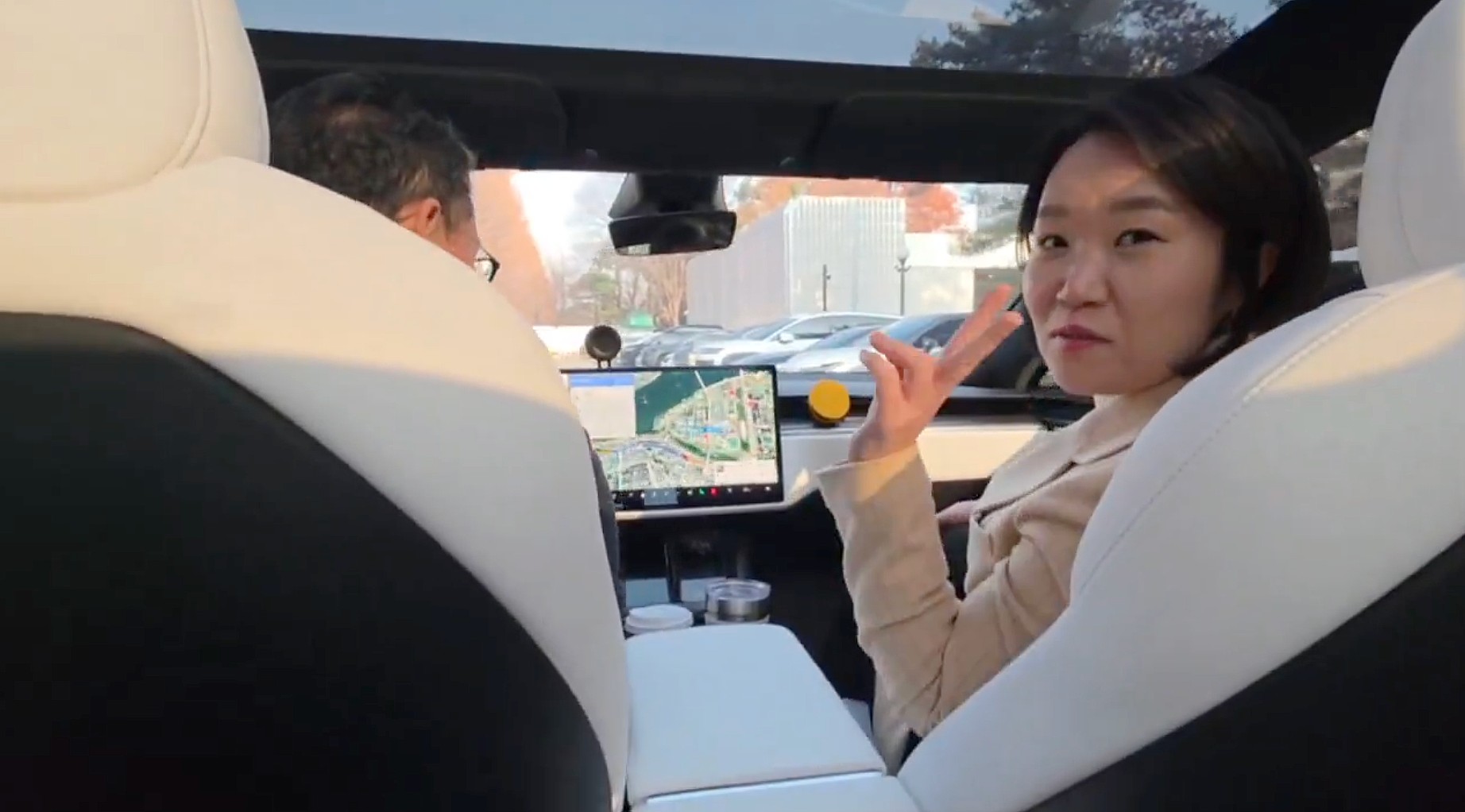
Tesla Full Self-Driving got its first sparkling review from South Korean politician Lee So-young, a member of the country’s National Assembly, earlier this week.
Lee is a member of the Strategy and Finance Committee in South Korea and is a proponent of sustainable technologies and their applications in both residential and commercial settings. For the first time, Lee was able to utilize Tesla’s Full Self-Driving technology as it launched in the country in late November.
Her thoughts on the suite were complimentary to the suite, stating that “it drives just as well as most people do,” and that “it already feels like a completed technology.”
드디어 오늘, 서울에서 테슬라 FSD 체험 했습니다.
JiDal Papa님의 모델S 협찬에 힘입어^^ 파파님 정말 감사합니다.
국회 -> 망원시장 -> 홍익대 -> 국회 복귀 코스였고요.
이미 무인 로보택시를 타봐서 그런지 신기함은
덜했지만, 웬만한 사람만큼 운전을 잘하네요.이미 완성된 기술이라고… pic.twitter.com/8pAidHBpRG
— 이소영 국회의원 (Soyoung Lee) (@im_soyounglee) December 17, 2025
Her translated post says:
“Finally, today I got to experience Tesla FSD in Seoul. Thanks to the Model S sponsored by JiDal Papa^^, I’m truly grateful to Papa. The route was from the National Assembly -> Mangwon Market -> Hongik University -> back to the National Assembly. Having already ridden in an unmanned robotaxi, the novelty wasn’t as strong for me, but it drives just as well as most people do. It already feels like a completed technology, which gives me a lot to think about. Once it actually spreads into widespread use, I feel like our daily lives are going to change a lot. Even I, with my license gathering dust in a drawer, don’t see much reason to learn to drive a manual anymore.”
Tesla Full Self-Driving officially landed in South Korea in late November, with the initial launch being one of Tesla’s most recent, v14.1.4.
It marked the seventh country in which Tesla was able to enable the driver assistance suite, following the United States, Puerto Rico, Canada, China, Mexico, Australia, and New Zealand.
It is important to see politicians and figures in power try new technologies, especially ones that are widely popular in other regions of the world and could potentially revolutionize how people travel globally.








